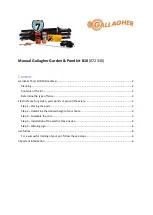
Jack Stands
•
Safely stow the jack stand(s) in the up position before
traveling. On Truckster direct connect chassis stow the
jack stands on the rear of the machine.
•
Check that the hitch pin and jack stand are not damaged,
and the safety pin is in place. (Replace safety pins if
missing or damaged).
•
Check that the hitch connections are not loose.
Hydraulic System
•
Check the hydraulic system for oil leaks. If you find a leak,
tighten the fitting, or replace or repair the damaged part.
•
Check the hydraulic hoses for wear or visible damage.
•
Check the hydraulic oil level. Fill up if necessary.
Belt and Rear Gate Seals
•
Check all rubber seals for wear or damage. Replace or
repair the seals if any leakage occurs.
•
Check and adjust the conveyor belt cleaning scraper.
Ensure the scraper is in full contact with the belt across
its length.
Options
•
Check the blades on the Twin Spinner discs for wear.
Replace when they wear thin.
•
Check the Twin Spinner housing for signs of cracking or
corrosion. Replace wear plates as required
•
Check that the safety decals are undamaged and legible,
otherwise, replace them.
Hydraulic System
The machine is shipped from the factory filled with high
quality hydraulic fluid. Check the level of hydraulic oil
before the machine is first started and daily thereafter. The
recommended replacement oil is as follows:
Toro PremiumTransmission/Hydraulic Tractor Fluid
(Available in 5 gallon pails or 55 gallon drums. See parts
catalog or Toro distributor for part numbers.)
Alternate fluids: If the Toro fluid is not available, other
petroleum-based Universal Tractor Hydraulic Fluids (UTHF)
may be used provided its specifications fall within the listed
range for all the following material properties and it meets
industry standards. We do not recommend the use of
synthetic fluid. Consult with your lubricant distributor to
identify a satisfactory product.
Note:
Toro will not assume responsibility for damage
caused by improper substitutions, so use only products
from reputable manufacturers who will stand behind their
recommendation.
Material Properties:
Viscosity, ASTM D445
cSt @ 40°C 55 to 62
cSt @ 100°C 9.1 to 9.8
Viscosity Index ASTM
D2270
140 to 152
Pour Point, ASTM D97
-35°F to -46°F
Industry Specifications:
API GL-4, AGCO Powerfluid 821 XL, Ford New Holland
FNHA-2-C-201.00, Kubota UDT, John Deere J20C,
Vickers 35VQ25, and Volvo WB-101/BM
Note:
Many hydraulic fluids are almost colorless, making it
difficult to spot leaks. A red dye additive for the hydraulic
system oil is available in 2/3 oz. (20 ml) bottles. One bottle
is sufficient for 4-6 gal (15-22 1) of hydraulic oil. Order part
number 44-2500 from your authorized Toro distributor.
Maintaining the Conveyor Belt
System
Conveyor Belt and Rollers
•
Check that the conveyor belt is tracking straight on the
rollers and does not slip. Make adjustments if necessary.
See the Conveyor Belt Tracking Procedure in this manual.
•
Check the front and rear roller bearings every two months
for wear or visible damage.
•
Check the condition and tension of the drive chain and
the sprockets.
Important:
Check for trapped spreading material
between conveyor bed, belt, and rollers. See How to
Wash the machine in this manual.
Conveyor Belt Tensioning
Perform the tensioning procedure only if the belt is slipping,
if it has been replaced, or if it has been loosened to replace
other parts.
1.
Place the belt’s V-guide in the guides of the front and
rear rollers.
2.
Tighten the two belt adjustment nuts evenly until the
belt is snug. (If necessary, remove the front idler roller
cover and the rear chute cover).
3.
Fully load the machine with the heaviest material you
expect to use.
4.
With two wrenches, hold the end of the tensioner rod
stationary and then loosen the locking nut, which is the
nut closest to the end of the rod (
).
35










































